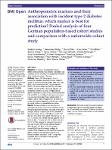Anthropometric markers and their association with incident type 2 diabetes mellitus: which marker is best for prediction? Pooled analysis of four German population-based cohort studies and comparison with a nationwide cohort study
Hartwig, Saskia
Kluttig, Alexander
Tiller, Daniel
Fricke, Julia
Müller, Grit
Schipf, Sabine
Völzke, Henry
Schunk, Michaela
Meisinger, Christa
Schienkiewitz, Anja
Heidemann, Christin
Moebus, Susanne
Pechlivanis, Sonali
Werdan, Karl
Kuss, Oliver
Tamayo, Teresa
Haerting, Johannes
Greiser, Karin Halina
Objective: To compare the association between different anthropometric measurements and incident type 2 diabetes mellitus (T2DM) and to assess their predictive ability in different regions of Germany. Methods: Data of 10 258 participants from 4 prospective population-based cohorts were pooled to assess the association of body weight, body mass index (BMI), waist circumference (WC), waist-to-hip-ratio (WHR) and waist-to-height-ratio (WHtR) with incident T2DM by calculating HRs of the crude, adjusted and standardised markers, as well as providing receiver operator characteristic (ROC) curves. Differences between HRs and ROCs for the different anthropometric markers were calculated to compare their predictive ability. In addition, data of 3105 participants from the nationwide survey were analysed separately using the same methods to provide a nationally representative comparison. Results: Strong associations were found for each anthropometric marker and incidence of T2DM. Among the standardised anthropometric measures, we found the strongest effect on incident T2DM for WC and WHtR in the pooled sample (HR for 1 SD difference in WC 1.97, 95% CI 1.75 to 2.22, HR for WHtR 1.93, 95% CI 1.71 to 2.17 in women) and in female DEGS participants (HR for WC 2.24, 95% CI 1.91 to 2.63, HR for WHtR 2.10, 95% CI 1.81 to 2.44), whereas the strongest association in men was found for WHR among DEGS participants (HR 2.29, 95% CI 1.89 to 2.78). ROC analysis showed WHtR to be the strongest predictor for incident T2DM. Differences in HR and ROCs between the different markers confirmed WC and WHtR to be the best predictors of incident T2DM. Findings were consistent across study regions and age groups (
No license information

